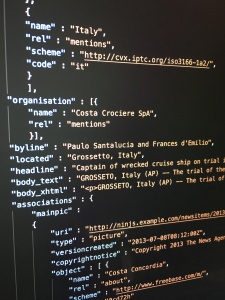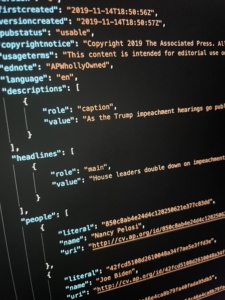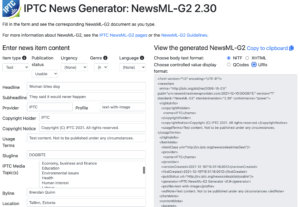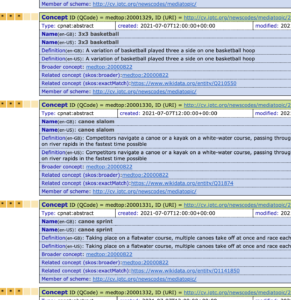Categories
Archives
 At the IPTC Spring Meeting in May 2022, IPTC’s Standards Committee voted to approve ninjs 1.4, the latest version in the 1.x track of IPTC’s standard for news content in the JSON format.
At the IPTC Spring Meeting in May 2022, IPTC’s Standards Committee voted to approve ninjs 1.4, the latest version in the 1.x track of IPTC’s standard for news content in the JSON format.
Johan Lindgren of TT Nyhetsbyrån, Lead of the IPTC News in JSON Working Group, said:
“After the launch of ninjs 2.0 in the autumn of 2021, we received requests to add some of the new 2.0 features to the first generation of ninjs, so that those who are using the 1.x branch of ninjs can use the new features without making breaking changes. So we are excited to publish version 1.4 of ninjs, where these features are included.”
Those changes include:
- New property contentcreated, denoting the date and time when the content of this ninjs object was originally created (as opposed to the date and time when the ninjs object itself was created). For example, an old photo that is now handled as a ninjs object may have a firstcreated and versioncreated of “2022-06-02T12:00:00+00:00”, but a contentcreated value of “1933-04-03T00:00:00+00:00”. The contents must be a valid JSON Schema date-time object.
- New property expires, showing “the date and time after which the Item is no longer considered editorially relevant by its provider.” Note that this is not the same as a rights-related expiration, it simply conveys the desire of the content creator to highlight the content until a certain time. A good example might be a football match preview, which would no longer be editorially relevant after the game commences. The contents must be a valid JSON Schema date-time object.
- New property rightsinfo, which holds an expression of rights to be applied to the content. It contains sub-properties langid (a URI which specifies the language used to specify rights such as RightsML or ODRL), and one of either linkedrights (containing a link to a remotely-hosted declaration of the rights associated with the content) or encodedrights (which includes an embedded encoding of the rights statements within the ninjs object).
Which version of ninjs should I choose for my project?
There might be some confusion since we have released ninjs 1.4 after the release of ninjs 2.0. Please note that this is simply an update to the 1.x branch of ninjs to make it easier for users who cannot upgrade to 2.x branch due to breaking changes.
If you are starting a new project that requires JSON-encoded news content, we recommend using ninjs 2.0. This version should be easiest for developers to work with.
If you are already using a 1.x version of ninjs, we recommend at least upgrading to version 1.4. This should be an easy change, because 1.4 is backwards-compatible with versions 1.0, 1.1, 1.2 and 1.3. We would also recommend upgrading to 2.0 if possible, but if not, 1.4 is the best version of the 1.x branch.
Supporting materials for ninjs 1.4 and ninjs 2.0 can be found at these locations:
- JSON Schema for ninjs 1.4: https://iptc.org/std/ninjs/ninjs-schema_1.4.json
- JSON Schema for ninjs 2.0: https://iptc.org/std/ninjs/ninjs-schema_2.0.json
- User Guide for ninjs (covering version 2.0 but mentioning 1.4): https://iptc.org/std/ninjs/userguide/
- The ninjs Generator has been updated to output 1.4-compatible JSON: https://www.iptc.org/std/ninjs/generator/
Thanks to Johan and the IPTC News in JSON Working Group for working on this release.
We have just released a small update to the Media Topics contr olled vocabulary for news and media content. The changes support the Winter Olympics which starts this week.
olled vocabulary for news and media content. The changes support the Winter Olympics which starts this week.
The changes are:
- The definition of bobsleigh (medtop:20000854) was changed to reflect the fact that bobsleigh now offers a one-person version (which is incidentally referred to as “monobob”). The new definition is: One, two or four people racing down a course in a sled that consists of a main hull, a frame, two axles and sets of runners. The total time of all heats in a competition is added together to determine the winner.
- Similarly, the definition of freestyle skiing (medtop:20001058) was changed to reflect new events this year. The new definition is: Skiing competitions which, in contrast to alpine skiing, incorporate acrobatic moves and jumps. Events include aerials, halfpipe, slopestyle, ski cross, moguls and big air.
We also took the opportunity to add a term which was recently suggested by ABC Australia and Fourth Estate in the US:
- tsunami (medtop:20001353), child of medtop:20000151 natural disaster – High and powerful ocean waves caused by an underwater land disturbance, such as an earthquake or volcanic eruption, known to cause significant damage and loss when they hit land
We would like to thank to all Media Topics users and maintainers for their feedback and support.
The IPTC NewsCodes Working Group has now released the Q4 update to Media Topics, IPTC’s subject taxonomy used for classifying news content.
The main changes were made to the religion branch as part of our regular review cycle, and to sport events after discussing the terms with the Sports Content Working Group. This means that we have retired 29 terms and added 15 others. So in total we currently have 1,159 active terms in the vocabulary.
All new terms were created in en-GB and en-US versions, and have translations in Norwegian thanks to NTB. Other language translations will be added as they are contributed.
Below is a list of all of the changes.
New terms:
- medtop:20001338 education policy
- medtop:20001339 wellness
- medtop:20001340 mental wellbeing
- medtop:20001341 regular competition
- medtop:20001342 playoff championship
- medtop:20001343 final game
- medtop:20001344 Catholicism
- medtop:20001345 bar and bat mitzvah
- medtop:20001346 canonisation
- medtop:20001347 Shia Islam
- medtop:20001348 Sunni Islam
- medtop:20001349 atheism and agnosticism
- medtop:20001350 Eid al-Adha
- medtop:20001351 Hasidism
- medtop:20001352 Hanukkah
Retired terms:
- medtop:20000660 ecumenism
- medtop:20000662 Old Catholic
- medtop:20000665 Anglican
- medtop:20000666 Baptist
- medtop:20000667 Lutheran
- medtop:20000668 Mennonite
- medtop:20000669 Methodist
- medtop:20000670 Reformed
- medtop:20000671 Roman Catholic
- medtop:20000672 concordat
- medtop:20000675 Freemasonry
- medtop:20000687 interreligious dialogue
- medtop:20000689 religious event
- medtop:20000701 temple
- medtop:20001109 continental championship
- medtop:20001110 continental cup
- medtop:20001111 continental games
- medtop:20001112 international championship
- medtop:20001113 international cup
- medtop:20001114 international games
- medtop:20001115 national championship
- medtop:20001116 national cup
- medtop:20001117 national games
- medtop:20001118 regional championship
- medtop:20001119 regional cup
- medtop:20001120 regional games
- medtop:20001121 world championship
- medtop:20001122 world cup
- medtop:20001123 world games
Label changes:
- medtop:12000000 religion and belief -> religion
- medtop:20000128 international court or tribunal -> international court and tribunal
- medtop:20000423 environmental politics -> environmental policy
- medtop:20000458 mental health and disorders -> mental health
- medtop:20000657 religious belief -> belief systems
- medtop:20000661 Mormon -> Mormonism
- medtop:20000663 Orthodoxy -> Christian Orthodoxy
- medtop:20000664 Protestant -> Protestantism
- medtop:20000674 cult and sect -> cult
- medtop:20000690 religious festival or holiday -> religious festival and holiday
- medtop:20000697 religious facilities -> religious facility
- medtop:20000702 religious institutions and state relations -> relations between religion and government
Definition changes:
- medtop:12000000 religion
- medtop:20000117 arbitration and mediation
- medtop:20000423 environmental policy
- medtop:20000657 belief systems
- medtop:20000658 Buddhism
- medtop:20000659 Christianity
- medtop:20000661 Mormonism
- medtop:20000664 Protestantism
- medtop:20000673 Confucianism
- medtop:20000674 cult
- medtop:20000676 Hinduism
- medtop:20000677 Islam
- medtop:20000678 Jainism
- medtop:20000679 Judaism
- medtop:20000680 nature religion
- medtop:20000681 Zoroastrianism
- medtop:20000682 Scientology
- medtop:20000683 Shintoism
- medtop:20000684 Sikhism
- medtop:20000685 Taoism
- medtop:20000686 Unificationism
- medtop:20000690 religious festival and holiday
- medtop:20000691 Christmas
- medtop:20000692 Easter
- medtop:20000693 Pentecost
- medtop:20000694 Ramadan
- medtop:20000695 Yom Kippur
- medtop:20000696 religious ritual
- medtop:20000697 religious facility
- medtop:20000698 church
- medtop:20000699 mosque
- medtop:20000700 synagogue
- medtop:20000702 relations between religion and government
- medtop:20000704 pope
- medtop:20000705 religious text
- medtop:20000706 Bible
- medtop:20000708 Torah
- medtop:20001271 All Saints Day
- medtop:20001273 baptism
Hierarchy moves:
- medtop:20000423 environmental policy moved from medtop:06000000 environment to medtop:20000621 government policy
- medtop:20000479 healthcare policy moved from medtop:07000000 health to medtop:20000621 government policy
- medtop:20000480 government health care moved from medtop:20000479 healthcare policy to medtop:07000000 health
- medtop:20000483 health insurance moved from medtop:20000479 healthcare policy to medtop:07000000 health
- medtop:20000690 religious festival and holiday moved from medtop:20000689 religious event to medtop:12000000 religion
- medtop:20000696 religious ritual moved from medtop:20000689 religious event to medtop:12000000 religion
- medtop:20001177 Olympic Games moved from medtop:20001123 world gamesto medtop:20001108 sport event
- medtop:20001178 Paralympic Games moved from medtop:20001123 world games to medtop:20001108 sport event
- medtop:20001239 exercise and fitness moved from medtop:10000000 lifestyle and leisure to medtop:20001339 wellness
- medtop:20001293 streaming service moved from medtop:20000045 mass media to medtop:20000304 media
As always, the Media Topics vocabularies can be viewed in the following ways:
- In a collapsible tree view
- As a downloadable Excel spreadsheet
- On one page on the cv.iptc.org server
- In machine readable formats such as RDF/XML and Turtle using the SKOS vocabulary format: see the cv.iptc.org guidelines document for more detail.
For more information on IPTC NewsCodes in general, please see the IPTC NewsCodes Guidelines.
At the recent IPTC Standards Committee Meeting, NewsML-G2 version 2.30 was approved.
The full NewsML-G2 XML Schema, NewsML-G2 Guidelines document and NewsML-G2 specification document have all now been updated.
The biggest change (Change Request CR00211) is that <catalogRef/> and <catalog/> elements are now optional. This is so that users who choose to use full URIs instead of QCodes do not need to include an unnecessary element.
The other user-facing change is CR00212 which adds residrefformat and residrefformaturi attributes to the targetResourceAttributes attribute group, used in <link>, <icon> and <remoteContent>.
Other changes CR00213 and CR00214 aren’t visible to end users and don’t change any functionality, but make the XML Schema easier to read and maintain.
- The top-level folder of the NewsML-G2 v2.30 release is http://iptc.org/std/NewsML-G2/2.30/.
- The NewsML-G2 Implementation Guidelines document, updated to cover version 2.30 is available at https://www.iptc.org/std/NewsML-G2/guidelines
- The latest NewsML-G2 Specification document is available at https://www.iptc.org/std/NewsML-G2/specification/
- The XML Schema for NewsML-G2 v2.30 is at http://iptc.org/std/NewsML-G2/2.30/specification/NewsML-G2_2.30-spec-All-Power.xsd
XML Schema documentation of version 2.30 version is available on GitHub and at http://iptc.org/std/NewsML-G2/2.30/specification/XML-Schema-Doc-Power/.
NewsML-G2 Generator updated
The NewsML-G2 Generator has been updated to use version 2.30. This means that catalogRef is only included if QCode mode is chosen. The Generator also uses the new layout which means that the target document is updated in real time as the form is completed.
To follow our work on GitHub, please see the IPTC NewsML-G2 GitHub repository.
The full NewsML-G2 change log showing the Change Requests included in each new version is available at the dev.iptc.org site.

Today, IPTC announces the release of version 2.0 of the news industry’s standard for exchanging content in JSON: ninjs.
The new version introduces a completely new way of declaring multiple headlines, body texts and description fields, which is compatible with binary data serialisation formats such as Avro and Protocol Buffers.
“We are very excited about releasing the 2.0-version of News in JSON (ninjs),” says Johan Lindgren (TT), lead of the working group responsible for developing the standard. “When working on improving the 1.3 version, we realised that a number of suggestions would mean breaking changes and after some consideration we took that step. Now we have a version of ninjs that is better suited for APIs, databases like Elastic and conversion to binary methods like Protocol Buffers.”
The IPTC News in JSON Working Group has kept the original focus on two main use cases: data in transit and data at rest.
In recent years, more systems have started to convert from JSON formats into binary data serialisation protocols such as Avro and Protocol Buffers for data in transit. However ninjs 1.x couldn’t be converted into these protocols because of the dynamic way that keys could be defined, for example “headline_main” and “headline_subhead”. In ninjs 2.0, all properties are given well-defined names, so they can be converted into Protobufs schemas. The GitHub repository for ninjs now includes a demonstration of how ninjs 2.0 can be used with Protocol Buffers.
Other tools included in the repository are an example GraphQL server for ninjs and example XSLTs to convert from IPTC XML-based formats like NewsML and NITF.
The ninjs Generator tool has been updated to create ninjs 2.0. In fact, using the tool, users can switch between generating ninjs 1.3 and ninjs 2.0 output at the click of a radio button.
The official location of the ninjs 2.0 JSON Schema is https://iptc.org/std/ninjs/ninjs-schema_2.0.json.
A full list of the changes in ninjs 2.0 can be viewed in section 7.5 of the ninjs User Guide.
The latest version of the International Press Telecommunications Council IPTC’s Photo Metadata Standard includes two new properties: Alt Text (Accessibility) and Extended Description (Accessibility). These will make it easier for software companies, publishers, and website developers to make websites and electronic publications more accessible.
These new properties will be introduced to the public and discussed in detail at the IPTC Photo Metadata Conference, held online next Thursday, 4th November. Registration to the IPTC Photo Metadata Conference is free and open to all.
“A major milestone in accessibility is realised through the inclusion of embedded alt text and extended descriptions as IPTC metadata for digital images,” said Beth Ziebarth, Director of Access Smithsonian. “All publicly available images can now be made accessible. As with any good inclusive practice, this benefits a range of digital image users and producers. The foresight of the IPTC Photo Metadata Working Group is commendable.”
Web accessibility is mission-critical in our digitally inclusive age. As the number of images added to the web increases every day, the visual gap widens for people using assistive technologies, especially if they are blind. Embedding image descriptions for accessibility into photo metadata promises to be a game-changer, making it possible for software and systems to routinely provide alt text with images, thus giving screen reader software the ability to help readers visualise and listen to image descriptions as they are read out loud. Without accessible descriptions, images are silent for the millions who rely on screen readers to fully access the web.
As Richard Orme, CEO of the DAISY Consortium, has pointed out, “Up to 250 million people with blindness or moderate to severe vision impairment can benefit from image descriptions, plus countless more people with diverse information processing differences such as dyslexia who use text-to-speech technology for reading.”
The year 2020 was pivotal for web accessibility. Many disabled people were at high risk of severe illness from COVID-19 but struggled to access the essentials online — everything from healthcare and education to groceries and supplies. Inaccessible websites and applications have always been a barrier; during COVID, they became a threat to the health and safety of a vulnerable population.
Image descriptions are essential for people with visual impairments using assistive technologies and a fundamental requirement of the World Wide Web Consortium’s (W3C) Web Content Accessibility Guidelines (WCAG), the most widely-used guidelines for web accessibility in the world (W3C Web Accessibility Laws and Policies).
IPTC’s new accessibility properties will make it easier for platforms and software to comply with WCAG requirements and deliver images that are inclusive for everyone. Embedding accessible image descriptions into the photo metadata will make it possible for alt text and extended descriptions to travel wherever the image goes on the web or in books or other documents provided as EPUBs.
If you are interested, there are a few things you can do now:
- Attend the IPTC Photo Metadata Conference on November 4th to understand more about the new properties and how you can use them.
- Contact your software providers to tell them about these new properties and emphasise that these features are very important to you. Ask them when they will make the new properties available in their user interface.
- Contact your web content management software provider to make that case as well.
- For larger enterprises, think about how you could implement these properties into your organisation’s workflow.
The online IPTC Photo Metadata Standard specification will be updated to the new version on 4 November 2021.
We have just released the Q3 update to Media Topics, IPTC’s subject taxonomy used for classifying news content.
Most were changes to the education branch, following our regular review cycle. We also added some missing Norwegian translations (thanks to Tor Kristian Flage at NTB) and fixed some incorrect Wikidata mappings.
The changes are listed below. All changes are in both en-GB and en-US versions unless otherwise noted.
New terms:
- medtop:20001337 online and remote learning
Label changes:
- medtop:20000398 parent organisation -> parents group
- medtop:20001215 independent schools -> independent school (en-GB), independent and charter school (en-US)
- medtop:20000409 preschool -> early childhood educatio
- medtop:20001214 private schools -> private school
- medtop:20001213 public schools -> public school (en-US), state school (en-GB)
- medtop:20000403 adult education -> adult and continuing education (definition also changed, and moved to become a child of medtop:20000400 school)
- medtop:20000413 examination -> educational testing and examinations (definition also changed, and moved to be a child of medtop:05000000 education)
- medtop:20000405 higher education -> college and university (definition also changed)
- medtop:20000401 elementary schools -> primary education (definition also changed)
- medtop:20000408 middle schools -> lower secondary education (definition also changed)
- medtop:20000404 high schools -> upper secondary education (definition also changed)
- medtop:20001212 religious schools -> religious school (definition also changed)
Definition changes:
- medtop:05000000 education
- medtop:20000399 religious education
- medtop:20000400 school
- medtop:20000410 social learning
- medtop:20001216 vocational education
- medtop:20001217 educational grading (also moved to be a child of medtop:05000000 education)
- medtop:20000414 entrance examination (also moved to be a child of medtop:05000000 education)
- medtop:20000415 students (also moved to become a child of medtop:05000000 education)
- medtop:20000416 teachers (also moved to become a child of medtop:05000000 education)
Hierarchy change (in addition to those listed above):
- medtop:20000412 curriculum: moved to become a child of medtop:05000000 education
Retired terms:
- medtop:20000030 music theatre (its children are moved up to become children of medtop:20000029 theatre)
- medtop:20000411 teaching and learning (its children are now become children of medtop:05000000 education )
- medtop:20000406 college
- medtop:20000407 university
- medtop:20000402 further education
As usual, the Media Topics vocabularies can be viewed in the following ways:
- In a collapsible tree view
- As a downloadable Excel spreadsheet
- On one page on the cv.iptc.org server
- In machine readable formats such as RDF/XML and Turtle using the SKOS vocabulary format: see the cv.iptc.org guidelines document for more detail.
For more information on IPTC NewsCodes in general, please see the IPTC NewsCodes Guidelines.
In time for the 2020 Summer Olympics, soon to be held in Tokyo Japan (in 2021), we have released a new version of the Media Topics vocabulary covering all Olympic sports.
As many MediaTopics users don’t use the sports facets system, we wanted to make sure that the top-level Olympic and Paralympic sports were all represented in the main Media Topics vocabulary.
To make this possible, we have made the following changes:
New and changed labels and definitions for Olympics and Paralympics
We have added the following new sport concepts, all under Competition Discipline:
- medtop:20001329 3×3 basketball
- medtop:20001330 canoe slalom
- medtop:20001331 canoe sprint
- medtop:20001332 bmx freesytle
- medtop:20001333 road cycling
- medtop:20001334 track cycling
- medtop:20001335 football 5-a-side
- medtop:20001336 goalball
Modified labels:
- medtop:20001093 weightlifting -> weightlifting and powerlifting
- medtop:20000895 bmx -> bmx racing
We have “unretired” the following term, which was retired in 2017:
- medtop:20001077 marathon swimming
We have moved the following term:
- medtop:20000887 sport climbing to under “competition discipline”
Updated translations
In another major update we have added labels in French, Spanish and Arabic for most recently-added terms. Thanks to Anne Raynaud and her team at Agence France-Presse (AFP) for this contribution.
Another small change is that in the HTML tree view, we now mark retired concepts more clearly by visually striking out their labels and definitions.
We always welcome feedback on IPTC MediaTopics and the other NewsCodes vocabularies on the public discussion list iptc-newscodes@groups.io.

We are pleased to announce the latest release of IPTC NewsCodes, including our main subject vocabulary for news content, IPTC MediaTopics.
This update includes:
New Media Topics terms
The new terms were requested by MediaTopics users Ritzau in Denmark, NTB in Norway and AFP in France.
- drowning (https://cv.iptc.org/newscodes/mediatopic/20001321)
- men (https://cv.iptc.org/newscodes/mediatopic/20001328)
- poisoning (https://cv.iptc.org/newscodes/mediatopic/20001322)
- sports coaching (https://cv.iptc.org/newscodes/mediatopic/20001323)
- sports management and ownership (https://cv.iptc.org/newscodes/mediatopic/20001324)
- sports officiating (https://cv.iptc.org/newscodes/mediatopic/20001325)
- torture (https://cv.iptc.org/newscodes/mediatopic/20001320)
- women (https://cv.iptc.org/newscodes/mediatopic/20001327)
- women’s rights (https://cv.iptc.org/newscodes/mediatopic/20001326)
Retired Media Topics terms
- accomplishment (https://cv.iptc.org/newscodes/mediatopic/20000497). Use award and prize (20000498) or record and achievement (20000499) instead.
- people (https://cv.iptc.org/newscodes/mediatopic/20000502). Use more specific terms instead.
Label changes to Media Topics
Please note that we only ever make changes to labels to make the meaning clearer, we never change the meaning of a term.
- transfer -> sports transaction (http://cv.iptc.org/newscodes/mediatopic/20001148)
- minister (government) -> minister and secretary (government) (http://cv.iptc.org/newscodes/mediatopic/20000613)
- “athletics, track & field” -> “athletics” in en-GB and “track and field” in en-US (http://cv.iptc.org/newscodes/mediatopic/20000827)
- plant -> flowers and plants (http://cv.iptc.org/newscodes/mediatopic/20000507)
- imperial and royal matters -> royalty (http://cv.iptc.org/newscodes/mediatopic/20000506)
Media Topics hierarchy moves
- “award and prize” (20000498) and record and achievement (20000499) were moved to the top level “human interest” term because we retired the parent term “accomplishment”
- birthday (20001238), celebrity (20000505), high society (20000504) and “human mishap” (20000503) were moved to the top level “human interest” term to under the top level “human interest” term because we retired the parent term “people”.
Definition changes in Media Topics
- Changes under “human interest” branch: animal (20000500), anniversary (20001237), award and prize (20000498), ceremony (20000501), funeral and memorial service (20001235), wedding (20001236), birthday (20001238)
- Grammar fixes in en-GB and en-US descriptions for 20000037, 03000000, 20000140, 20000215, 20000228, 20000279, 20000321, 20000327, 20000390, 20000426, 20001229, 20001220, 20000504, 20000339, 20000571, 20000575, 20000590, 20000591, 20000600, 20000604, 20000619, 20000630, 20000658, 20000852
Changes to mappings from MediaTopics to other vocabularies
We had a major review of MediaTopic to Wikidata mappings, thanks to Lucy Butcher from Wirecutter (part of The New York Times, an IPTC member) for her contributions. Many terms have had their WIkidata mappings edited or added. In the near future, we are planning to add mappings from Wikidata back to NewsCodes.
Changes to other NewsCodes vocabularies
The Genre vocabulary had a major update, the second half of the review that was started in the February release.
New Genre terms:
- Live Coverage (http://cv.iptc.org/newscodes/genre/LiveCoverage)
- Preview (http://cv.iptc.org/newscodes/genre/Preview)
Retired terms:
- Scener (https://cv.iptc.org/newscodes/genre/Scener) – use From the Scene instead
- Text only (https://cv.iptc.org/newscodes/genre/Text_only) – Use Transcript and Verbatim instead
- Update (https://cv.iptc.org/newscodes/genre/Update) – Use Synopsis or Briefing instead
- Wrap (https://cv.iptc.org/newscodes/genre/Wrap) – Use Synopsis or Briefing instead
- Wrapup (https://cv.iptc.org/newscodes/genre/Wrapup) – Use Synopsis or Briefing instead
Label (and definition) changes:
- Daybook -> Planner (https://cv.iptc.org/newscodes/genre/Daybook)
- Listing of Facts -> Fact Box (https://cv.iptc.org/newscodes/genre/ListingOfFacts)
- Summary -> Briefing (https://cv.iptc.org/newscodes/genre/Summary)
Definition changes for: Biography, Birth Announcement, Curtain Raiser, Exclusive, Feature, Fixture, Forecast, From the Scene, Interview, Music, Obituary, Opinion, Polls and Surveys, Press Release, Press-Digest, Profile, Program, Question and Answer Session, Quote, Raw Sound, Response to a Question, Results Listings and Statistics, Retrospective, Review, Side bar and Supporting Information, Special Report, Synopsis.
As usual, all changes can be seen:
- Directly on the CV server at http://cv.iptc.org/
- In machine-readable form using SKOS, NewsML-G2 and NewsML 1 (see the cv.iptc.org guidelines for details)
- HTML tree view at https://www.iptc.org/std/NewsCodes/treeview/mediatopic/mediatopic-en-GB.html
- As an interactive diagram on http://show.newscodes.org/
- In Excel format from https://www.iptc.org/std/NewsCodes/IPTC-MediaTopic-NewsCodes.xlsx
Please let us know if you spot any problems. If you are an IPTC member you can post issues, questions and suggestions to the NewsCodes Working Group list at iptc-newscodes-dev@groups.io.
 We have just released a new version of IPTC NewsCodes, which includes many changes to Media Topics.
We have just released a new version of IPTC NewsCodes, which includes many changes to Media Topics.
This is the first major update since August 2020 (although we released new versions in September and October 2020 to add translations of new terms).
The changes are detailed below:
New translations for Media Topics
After many requests, we have now added an “en-US” language version, based on a contribution by Jeff Brown of Fourth Estate. Thanks Jeff!
Mostly it simply changes British English words to US English, such as “centre”/”center” and “programme”/”program”, but there are a few more substantive changes around cinema / movies and changing “holiday” to “vacation”. Also where Jeff had suggested changes to definitions, we often changed them for both British and US English.
en-GB will still be the primary language for Media Topics, but we will keep the en-GB and en-US versions in sync as we make changes.
New Media Topics terms
These were suggested by our collaborators from Ritzau via iMatrics, NTB, TT and AFP. Thanks to all.
- animal abuse (http://cv.iptc.org/newscodes/mediatopic/20001314)
- border disputes (http://cv.iptc.org/newscodes/mediatopic/20001316)
- cheerleading (http://cv.iptc.org/newscodes/mediatopic/20001309)
- child care (http://cv.iptc.org/newscodes/mediatopic/20001317)
- disinformation and misinformation http://cv.iptc.org/newscodes/mediatopic/20001319
- kickboxing (http://cv.iptc.org/newscodes/mediatopic/20001310)
- kiting (http://cv.iptc.org/newscodes/mediatopic/20001306) (which includes kitesurfing, kiteboarding, snowkiting and land kiting)
- krav maga (http://cv.iptc.org/newscodes/mediatopic/20001308)
- padel (http://cv.iptc.org/newscodes/mediatopic/20001305)
- pests (http://cv.iptc.org/newscodes/mediatopic/20001318)
- political leadership (http://cv.iptc.org/newscodes/mediatopic/20001312)
- sambo (martial art) (http://cv.iptc.org/newscodes/mediatopic/20001311)
- shootings (http://cv.iptc.org/newscodes/mediatopic/20001313)
- stand up paddleboarding (SUP) (http://cv.iptc.org/newscodes/mediatopic/20001307)
- sport achievement (http://cv.iptc.org/newscodes/mediatopic/20001301)
- sports award (http://cv.iptc.org/newscodes/mediatopic/20001304)
- sports medal (http://cv.iptc.org/newscodes/mediatopic/20001303)
- sports record (http://cv.iptc.org/newscodes/mediatopic/20001302)
- zoo (http://cv.iptc.org/newscodes/mediatopic/20001315)
Please note that the new terms only exist in en-GB and en-US right now, more translations will be added soon.
Update on 15 March: we have now added translations in Danish (thanks to Ritzau and iMatrics), Nowegian (thanks to NTB), Swedish (thanks to TT) and Portuguese for Brazil and Portugal (thanks to Priberam and Lusa).
Update on 12 April: We have now also added Chinese and German translations for these new and updated terms and definitions. Thanks very much to members Xinhua and dpa for their help!
Retired Media Topics terms
- sports facilities (http://cv.iptc.org/newscodes/mediatopic/20000559 (retired)) – use medtop:20001126 “sport venue” instead
- inline skating (http://cv.iptc.org/newscodes/mediatopic/20000967 (retired)) – use medtop:20001155 “roller sports” instead
Label changes to Media Topics
Please note that we only ever make changes to labels to make the meaning clearer, we never change the meaning of a term.
- online media -> online media outlet http://cv.iptc.org/newscodes/mediatopic/20000048
- traffic crime -> reckless driving (http://cv.iptc.org/newscodes/mediatopic/20001196)
- arbitration -> arbitration and mediation (http://cv.iptc.org/newscodes/mediatopic/20000117)
- prosecution -> prosecution and prosecutors (http://cv.iptc.org/newscodes/mediatopic/20000118)
- trade fair -> trade show or expo (http://cv.iptc.org/newscodes/mediatopic/20001136)
- online media -> online media industry (http://cv.iptc.org/newscodes/mediatopic/20000311)
- speciality store -> specialty store (http://cv.iptc.org/newscodes/mediatopic/20000253)
- motorbike enthusiasm -> motorcycle enthusiasm (http://cv.iptc.org/newscodes/mediatopic/20000571)
- parliament -> legislative body (http://cv.iptc.org/newscodes/mediatopic/20000615)
- synchronised swimming -> artistic swimming (http://cv.iptc.org/newscodes/mediatopic/20001175) (as per IOC changes for 2020 Olympics)
Media Topics hierarchy moves
- dropped criminal investigation (http://cv.iptc.org/newscodes/mediatopic/20001200) moved to under investigation (criminal) (http://cv.iptc.org/newscodes/mediatopic/20000131)
- bodybuilding (http://cv.iptc.org/newscodes/mediatopic/20001240) moved to under competition discipline (http://cv.iptc.org/newscodes/mediatopic/20000822)
Definition changes in Media Topics
- Updates to correct British English in en-GB definitions: 20000004, 20001181, 20000041, 20000068, 20000094, 20001283, 20000175, 20000246, 20000458, 20001247, 20000608, 20001292, 20000719, 20000724, 20000804, 20001193, 20000807, 20000835, 20001157
- Fixes to typos and spelling mistakes in en-GB definitions: 20001187, 20000088, 20000263, 20000469, 20000711
- Tweaks to definitions to make the meaning clearer:
- homicide (http://cv.iptc.org/newscodes/mediatopic/20000099)
- prison (http://cv.iptc.org/newscodes/mediatopic/20000137)
- civil law (http://cv.iptc.org/newscodes/mediatopic/20000122)
- police (http://cv.iptc.org/newscodes/mediatopic/20000133)
- real estate (http://cv.iptc.org/newscodes/mediatopic/20000241)
- mining (http://cv.iptc.org/newscodes/mediatopic/20000320)
- geriatric medicine (http://cv.iptc.org/newscodes/mediatopic/20000488)
- leisure venue (http://cv.iptc.org/newscodes/mediatopic/20000553)
- speed skating (http://cv.iptc.org/newscodes/mediatopic/20001067)
- sport venue (http://cv.iptc.org/newscodes/mediatopic/20001126)
Changes to other NewsCodes vocabularies
- http://cv.iptc.org/newscodes/contentprodpartyrole/ – new terms Fact Checker (http://cv.iptc.org/newscodes/contentprodpartyrole/factChecker) and author (http://cv.iptc.org/newscodes/contentprodpartyrole/author)
- http://cv.iptc.org/newscodes/newsprovider/ – new terms http://cv.iptc.org/newscodes/newsprovider/ACCESSWIRE and http://cv.iptc.org/newscodes/newsprovider/NEWSDIRECT
As usual, the changes can be seen:
- Directly on the CV server at http://cv.iptc.org/
- In machine-readable form using SKOS, NewsML-G2 and NewsML 1 (see the cv.iptc.org guidelines for details)
- HTML tree view at https://www.iptc.org/std/NewsCodes/treeview/mediatopic/mediatopic-en-GB.html
- As an interactive diagram on http://show.newscodes.org/
- In Excel format from https://www.iptc.org/std/NewsCodes/IPTC-MediaTopic-NewsCodes.xlsx
Please let us know if you spot any problems. If you are an IPTC member you can post issues, questions and suggestions to the NewsCodes Working Group list at iptc-newscodes-dev@groups.io.


